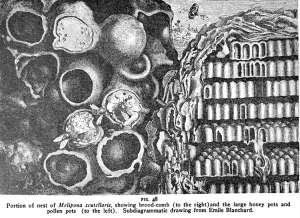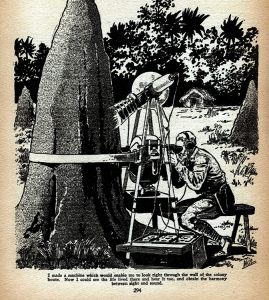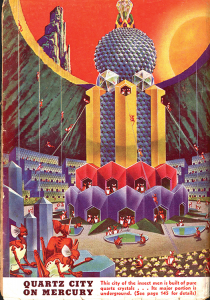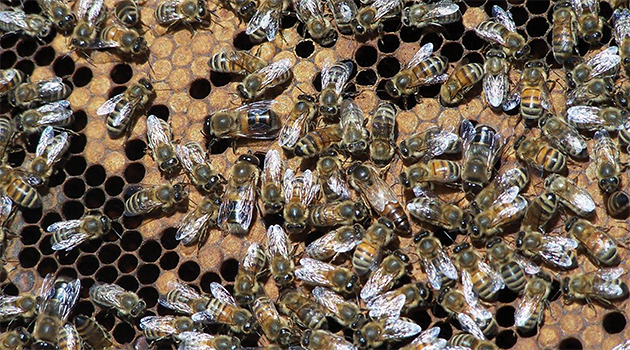By: Peter Borst
When I first got interested in honey bees, I had this feeling there was something unknown waiting to be discovered in the darkness of the hive.
I guess I am not the only one; from the book Swarm Intelligence:
Our study of swarm intelligence and collection adaptation is motivated in part by the uninformed suspicion there is wisdom to be gained from it, and by the feeling that there is something about the disorderly interactions of dumb actors and their achievements that is just, well, fascinating. (Kennedy 2001).
But are they dumb actors, or just very focused on a single purpose? There are thousands of species of bees and wasps, and very few live in colonies or hives. Most of them are solitary bees; solo females that raise the next generation and don’t stay around long enough to even see them emerge from their nurseries.
Solitary Bees
John Lubbock, in The Senses, Instincts, and Intelligence of Animals with Special Reference to Insects says: “The hive bee and the common wasps are so familiar and so interesting that they have to a great extent diverted attention from the so-called solitary species of the same groups.” We have little idea of when bees began to live in groups, but it is a wonderful fact that we can observe the range of life styles in bees living today. A small number of the solitary species form aggregations which hint at what might be accomplished if they established a more cooperative union.
The species Agapostemon (green sweat bee) lives in underground burrows and is known to form large “communes” of two hundred or more females. They have no division of labor, but gain the advantage of collective defense of the developing young. This arrangement gives a survival advantage to the individual members and so evolution would favor bees that live in shared burrows. The question then becomes whether solitary bees behave instinctively or exhibit some form of intelligence that responds in novel ways.
“A wide scale information collecting network such as the honey bee colony functions as well as it does because it cleaves to one purpose, the survival of the colony.”
“In considering the question whether these remarkable instincts were originally, so to say, engrafted in the insect – the very repetition which gave such remarkable results would tend to incapacitate the insect from dealing with any unusual conditions (Lubbock 1889).” Again, they are branded dumb actors: “one of the most striking instances of stupidity.”
The solitary bee, Megachile pyrenaica, makes mud cells. Little by little, she constructs a cell and fills it with honey. When it’s full she places an egg inside and seals the small opening with mud. The renowned naturalist Fabre, curious to explore the bee’s instincts, removed some of the mud, which she quickly repaired. Then, he made a small hole in the side of a cell, from which the honey began to drip out. Apparently, the bee had no instinct to deal with this. She simply kept putting in more honey, and the contents leaked out. There are countless similar examples throughout the animal world that illustrate the limits of instinct, and the need for creative solutions to unforeseeable problems.
 Evolution has produced many solutions to this dilemma. On the one hand, we see animals with large brains that combine instinct with problem solving capabilities. Alternatively, there are many species, having a very limited degree of awareness and intelligence, that have formed aggregations. This collective intelligence is what makes a “hive mind.”
Evolution has produced many solutions to this dilemma. On the one hand, we see animals with large brains that combine instinct with problem solving capabilities. Alternatively, there are many species, having a very limited degree of awareness and intelligence, that have formed aggregations. This collective intelligence is what makes a “hive mind.”
The Hive Mind
One of the earliest references to the hive mind occurs in the magazine Bee World. H.J. Wadey discusses honey bee orientation and he mentions a friend who suggested bees may be connected to their colony by a “thought beam” analogous to RADAR. Wadey immediately dropped that idea, but continued with the concept. He described how swarming bees keep together and form a new identity, once they have left the parent stand, “which might have ceased to exist for all the interest the swarm shows in it” (Wadey 1944).
They begin to form new memories associated with the new colony and ultimately its new location. He points out that the new identity is so strong, that they will not return to their former location, even if the queen is removed from the swarm. The exception to this keen sense of hive location is the phenomenon called “drifting,” which Wadey correctly points out is purely accidental. The older bees returning from the field have the strongest tendency to drift. It is likely that their mental abilities fade with age. Further, they are not rejected by guard bees, since they are not hostile invaders but just returning from the field with bounty.
The idea of the hive mind did not catch on right away. It was mentioned in passing by Stanley Gooding, the president of the British Bee-Keepers’ Association, in a 1958 address. He refers to:
Something which we might call the ‘Hive Mind’ … the needs of the colony itself. Work has been carried out by Lindauer, in Germany, upon the behaviour of dancing honey bees on the surface of a swarm. This rather points to honey bees being able, on occasions, to exercise a certain degree of choice which might be considered intelligence (Gooding 1958).
Colin Butler carried the idea forward in his 1973 presentation to the Royal Entomological Society of London. Butler referred back to Maeterlinck’s fanciful work called The Spirit of the Hive, and gave a nod to Wadey’s updated version. However, he moved the discussion away from intelligence and toward the recently discovered role of pheromones. Butler attributed much of the regulation of the colony to the queen and the “queen substance” which has such a profound effect on the entire group, even at a distance. Certainly the use of odoriferous pheromones plays an important part in the lives of insects.
“A colony of honey bees can live for many years in the same location while most insects live very short, seasonal lives.”
Naturally, these discoveries did not escape the notice of science fiction writers. In Hellstrom’s Hive (1973), Frank Herbert writes about human beings that have mutated into a hive-group, which is preparing to take over the world, complete with broodmother queens, drones, and chemically neutered “workers.” This theme was previously explored in Huxley’s Brave New World (1932), and subsequently used in countless dreary stories and films. The font for these fictions was the entomologist William Morton Wheeler, who coined the term superorganism in his 1928 book titled Emergent Evolution.
Wheeler saw “emergent properties” within the superorganism superseding the resident properties of the collective ants. Wheeler said the superorganism of the hive “emerges” from the mass of ordinary insect organisms. And he meant emergence as science – a technical, rational explanation – not mysticism or alchemy . . . The marvel of “hive mind” is that no one is in control. (Kelly 1994).
So writes Kevin Kelly, who connected the dots in his book, Out of Control, in which he extensively used the metaphor of the hive mind. Kelly had previously edited, published, and wrote much of Signal, a Whole Earth Catalog of Personal Communication Tools, which evaluated the technologies of faxes, satellite TV, cellular, digital retouching, online systems and the whole emerging world of digital technology. His thinking was prescient, in that he was able to foresee the emergence of a new form of intelligence from the network that was just beginning to form as personal computers were being linked around the world. He said, in 1988, “The complexity in question permeates key concepts like distributed learning (honey bees co-operating in a hive), and fault tolerant networks (a downed powerline doesn’t topple the electric grid).” Kelly and his colleagues developed the WELL (Whole Earth ‘Lectronic Link), which was one of the earliest online computer conferencing networks (Kelly 1988).
Swarm Intelligence
Meanwhile, modern day researchers were hard at work probing the minds of insect colonies. While Kelly was in Sausalito dreaming about hive minds, Tom Seeley was a professor at Yale (1980 to 1986) and after that, at Cornell University. His first major work was Honeybee Ecology: A Study of Adaptation in Social Life. In a more recent work, he wrote at length about the honey bee waggle dance, which the bees use to transmit information about their discoveries in the field, to other potential foragers, thereby optimizing the workforce.
The waggle dance increases a colony’s ability to collect food not only because it helps a colony’s foragers exploit food sources that are hard to find, but also because it helps them focus their efforts on the food sources that are best to exploit. In other words, the ability of a colony’s foragers to share information about food source location and quality endows the colony with a collective decision-making ability, or “swarm intelligence”, regarding where its foragers should work (Seeley 2012)
It is quite clear that a colony or superorganism is far more efficient than that number of individuals living independently. A colony of honey bees can live for many years in the same location while most insects live very short, seasonal lives. Some of this efficiency arises from teamwork, division of labor, and sheer numbers, but the colony also possesses a collective awareness that none of the individuals has.
This awareness is transmitted from individual to individual and is retained even as thousands of bees are lost daily from attrition. In other words, once a large patch of forage, or a reliable water source, is located, the memory of this is retained by the colony, even if the discoverers of it have long since passed on. By the same token, bees that habitually visit sites don’t live more than few weeks, so that memories can also fade when they are no longer valid.
Cognition stresses the intrinsic organizing capacity of the brain. This capacity is expressed best in faculties of active or working memory including directed attention, expectation, decision making, planning, rule extraction, spatial cognition, and communication. Focusing on these capacities of the brain requires a shift from a learning perspective to a memory processing perspective (Menzel 2012).
 It is already clear that the honey bee possesses a strong memory for and sense of location. But without the ability to communicate, this would be a private experience only. The dance communication system takes the behavior to the next level. It isn’t really helpful to imagine the honey bee colony as a big brain, nor to think of the bees themselves as cells or neurons in the brain. It is much more like a network of cars, similar to a mapping program that one can access on one’s smart phone.
It is already clear that the honey bee possesses a strong memory for and sense of location. But without the ability to communicate, this would be a private experience only. The dance communication system takes the behavior to the next level. It isn’t really helpful to imagine the honey bee colony as a big brain, nor to think of the bees themselves as cells or neurons in the brain. It is much more like a network of cars, similar to a mapping program that one can access on one’s smart phone.
These networks collect information about traffic conditions from autonomous drivers who are actually in traffic. This information is fed back to other drivers and without any oversight, traffic is optimized, simply by the information being collected and fed back. Obviously, this information is available to you, even after you have arrived at home. The consciousness of it is alive and ongoing. But without memory there can be no consciousness. In this way the individual bee’s memory becomes the repository for one facet of the collective memory of the hive mind.
Our consciousness creates the present, just as it creates the past, from many distributed clues scattered in our mind. Our memories (and our hive minds) are created in the same indistinct, haphazard way. The act of perceiving and the act of remembering are the same. Both assemble an emergent whole from many distributed pieces (Kelly 1994).
Honesty is the Best Policy
One of the most important aspects of a networked solution is honesty. For the system to work the members have to report accurately and without trying to coerce the group. An example of coercion is advertising. If a mapping program, for example, is biased by businesses trying to reroute traffic to their establishments, the program completely loses its value as a navigational tool, the purpose of which is to get from here to there efficiently. That is not to say that advertising is inappropriate; the users of map programs frequently rely on them to find goods and services. But the bees have no particular bias; the foragers report back on their findings as fairly as possible.
Seeley’s more recent work from Honeybee Democracy (2010) described how honey bees scout for new nest sites, soon after a swarm of bees alights on a branch or some other situation, referred to as a bivouac. Many scouts search the surrounding area for suitable homes. Once a scout has found one and evaluated it (how the bee does that is a marvel; it seems to have an innate set of requirements, much like a nesting bird) – then the bee returns to the colony and advertises the value of the site. They use the same waggle dance that bees use to announce nectar sources and to pass on the location to the follower bees. These recruits go evaluate the site, and report back.
The key to this system is honesty. The bees accurately report the quality of the site. If it is a terrific one, they lobby hard for it; if not, they simply give the information so that it will be available to the group, if there are not better choices available. This is quite the opposite of a human election, where the candidates all present themselves as the best for the job, while the voters are left to choose from a dubious lot who want to get elected for all the wrong reasons.
Psychology of Superorganisms
Returning to memory, Sasaki and Pratt (2018) ask the searching question:
If colonies learn, where exactly does the learning happen? Is it within the brains of individual insects, as a foraging bee learns the location, color, and odor of a rewarding flower? Or is learning somehow dispersed across the colony and its environment?
 They reiterate the fact that memories are retained collectively by increasing numbers of individuals, but they also include the role of chemicals. They refer to ants which leave marks on nests sites that they find to be non-suitable to deter other scouts from wasting their time on them. Certain species of bees similarly mark forage sites to help guide recruits. Beyond those examples, we know that when honey bees are actively engaged in the collection of nectar and pollen, the hives are permeated with fresh odors and flavors. This creates and reinforces a dynamic not unlike a marketplace, where the goods are displayed for all when the harvest is good and the tables are bare when it is not. These cues stimulate the actions of the hive bees, which busy themselves building new comb for honey storage, cleaning out old comb, and expanding the brood rearing activity in response to favorable conditions.
They reiterate the fact that memories are retained collectively by increasing numbers of individuals, but they also include the role of chemicals. They refer to ants which leave marks on nests sites that they find to be non-suitable to deter other scouts from wasting their time on them. Certain species of bees similarly mark forage sites to help guide recruits. Beyond those examples, we know that when honey bees are actively engaged in the collection of nectar and pollen, the hives are permeated with fresh odors and flavors. This creates and reinforces a dynamic not unlike a marketplace, where the goods are displayed for all when the harvest is good and the tables are bare when it is not. These cues stimulate the actions of the hive bees, which busy themselves building new comb for honey storage, cleaning out old comb, and expanding the brood rearing activity in response to favorable conditions.
Another form of colony memory is observed when a bee hive has been molested, say by a skunk. This annoyance has the effect of putting the colony on alert, and they will respond to any sort of disturbance much more quickly and aggressively than if they had been quiescent for a long period of time. Honey bees produce a strong penetrating odor (isopentyl acetate) that serves as an alarm to rouse the colony defense. Quite an appropriate tool to get a message quickly to all the individuals in the darkness of the hive or at a short distance from it; they have no other way of calling out to their nest mates.
The Future of the Hive Mind
At various times in history, people have looked at the colony and seen a reflection of their own predilections and desires. Centuries ago, it was thought that the King ruled the hive and the rest of its inhabitants were not much more than slaves, reflecting society at the time. Later, poets like Maeterlinck speculated about the Spirit of the Hive. Dystopian science fiction authors write of dire futures where human life degrades into meaningless toil for unseen masters. Other writers visualize the internet as a democratizing force that freely disperses information to the benefit of everyone, albeit for mundane goals such as shopping or collecting antiques. Jaron Lanier warned:
Every attempt to create a pure bottom-up, emergent network to coordinate human affairs also facilitates some new hub that inevitably becomes a center of power, even if that was not the intent. The whole supposedly open system will contort itself to that Sovereign Server, creating a new form of centralized power. More openness doesn’t work (Lanier, 2014).
Which brings us back to honesty. A wide scale information collecting network such as the honey bee colony functions as well as it does because it cleaves to one purpose, the survival of the colony. There is no cheating, no freeloading. However, it does have its dark side. When conditions are poor, the scouts begin looking for other colonies that are weak and poorly defended. Having found one such unfortunate, they will plunder its reserves until every individual is either beaten or left to starve.
Parting Shots
Self-organizing is a paradigm, and like all paradigms, it is socially constructed; the social and historical contexts give us perspective on the possibilities and limits of the stated knowledge claims (Rodgers 2012).
Bees were for us like the clouds; each of us saw in them what he wanted to see (Dorat-Cubières 1793).
One of the things I do when I am teaching beginning beekeepers is have them look at a frame covered with bees and ask them what they see. The answer is invariably: thousands of bees milling about. A commercial beekeeper would look at the same frame and say: six more weeks of hard labor. At this point, I am torn between seeing the hive as the extension of the queen’s genomic program, and as a beautiful cloud of brightly colored sprites.
References
Butler, C.G. 1973 The queen and the “spirit of the hive.” Physiological Entomology, 37(11), 59-65.
Dorat-Cubières 1793 Les abeilles ou l’heureux gouvernement. Paris : Gérod et Tessier.
Gooding, S. 1958 Modern research into bees and bee-keeping. Journal of the Royal Society of Arts, 106(5021), 303-321.
Kakutani, M. 2010 Texts Without Context: The Internet Mashes Up Everything We Know About Culture. The New York Times, 21.
Kelly, K. 1988 Signal: a whole earth catalog. Published by Harmony Books, a division of Crown Publishers, New York.
Kelly, K. 1994 Out of control: The rise of neo-biological civilization. Addison-Wesley Longman Publishing Co., Inc.
Kennedy J, Eberhart R, Shi Y 2001 Swarm intelligence. Morgan Kaufmann, San Francisco
Krause, J., Ruxton, G.D., & Krause, S. 2010 Swarm intelligence in animals and humans. Trends in ecology & evolution, 25(1), 28-34.
Lanier, J. 2014 Who owns the future? Simon and Schuster. Chicago.
Lubbock, J. 1889 On the senses, instincts, and intelligence of animals: with special reference to insects. K. Paul, Trench & Company.
Menzel, R. 2012 Learning and Memory: Commentary. In Honeybee Neurobiology and Behavior (pp. 485-492). Springer, Dordrecht.
Rodgers, D. M. 2012 The Socially Constructed Natural Origins of Self-Organization. In Origin (s) of Design in Nature (pp. 751-771). Springer, Dordrecht.
Sasaki, T., & Pratt, S.C. 2018 The Psychology of Superorganisms: Collective Decision Making by Insect Societies. Annual review of entomology, 63.
Seeley, T.D. 2012 Progress in understanding how the waggle dance improves the foraging efficiency of honey bee colonies. In Honeybee Neurobiology and Behavior (pp. 77-87). Springer, Dordrecht.
Wadey, H.J. 1944 Orientation. Bee World, 25(8), 59-61.







